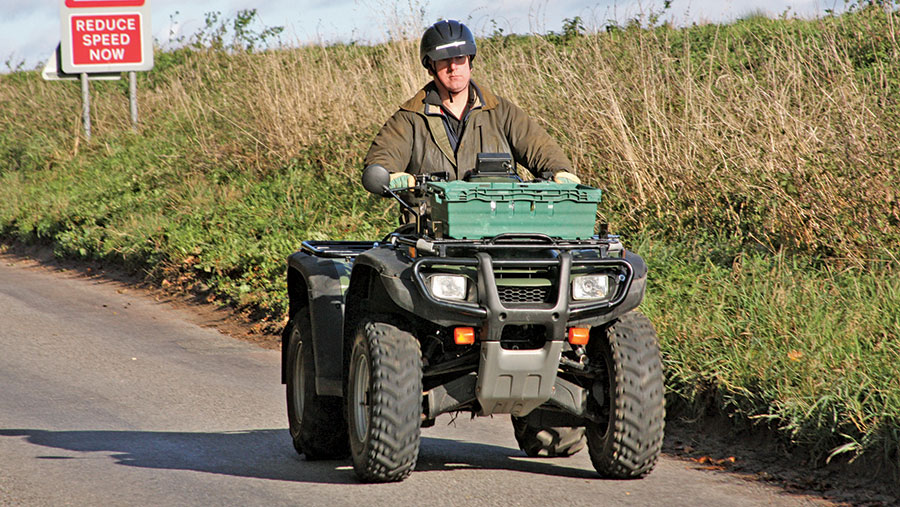Guide to keeping your farm ATV legal on the road
 An all-terrain-vehicle being driven legally on the road
An all-terrain-vehicle being driven legally on the road Lots of farmers use all-terrain-vehicles to scuttle between pockets of land, which means their bikes need to comply with UK road rules. So what are the dos and don’ts?
All-terrain-vehicles, or quad bikes, are designed for off-road use but many farmers and contractors often find themselves having to take them on public roads.
If this is the case there are several factors to consider.
See also: The latest reviews and buying advice on ATVs and UTVs
1. Taxation
Taxing your ATV is the first thing to consider and this depends on how it will be used.
If you never take the vehicle on road it won’t need to be taxed or registered and a driving licence is not needed.
Safety
However, you must take account of high accident levels with this type of relatively unstable vehicle and consider the safety and training of the driver as your first priority.
Helmets are not a legal requirement, but they are vital.
According to the Health and Safety Executive, many ATV fatalities in the UK have been caused by head injuries and helmets would have prevented most, if not all, of the deaths.
While the vast majority of recorded accidents occur off-road, an ATV and rider are vulnerable in traffic if involved in an accident and, with no cab or roll bars, the only protection may be a helmet.
This may not be a legal requirement but it may be life-saving in an accident.
A suitable helmet should be chosen that is manufactured and tested in accordance with the current relevant EN/BS standard.
Agricultural ATV
If you are going to use the ATV solely for agricultural, horticultural or forestry work and it will go on the roads, then you must register it with the DVLA and tax it as a special concessionary class agricultural machine – a ’light agricultural vehicle’. This is zero rated.
An agricultural ATV is defined in UK law as a light four-wheeled vehicle with a weight not exceeding 1000kgs and a single seat designed and constructed primarily for off road use.
The vehicle must be approved for road use and, as many quads don’t meet the necessary standards to be taken on road, you should check with your dealer or manufacturer that it meets the necessary requirements.
However, a two-seater bike falls under the restricted use banner and therefore has a 1.5km limit from the farm base.
Agriculturally taxed ATVs with a single seat are allowed to use red diesel both on and off the road.
2. MOT and maintenance
Like other agricultural vehicles, an agriculturally taxed ATV does not need an MOT.
However, it must be kept in roadworthy condition at all times and you must have a minimum of third party insurance.
It also needs to meet the relevant requirements of the Road Vehicles (Construction and Use) Regulations 1986 and the Road Vehicles (Lighting) Regulations 1989.
Compulsory kit
This means it needs to be kitted out with front and rear number plates, which must be lit after dark.
As an agricultural vehicle, it must also have a speedometer and a horn if it is driven at more than 20mph.
If the vehicle was first used on or after 1st April 1984, the speedometer should show speed in both miles per hour and kilometres per hour.
If the ATV will only be used in daylight and is not fitted with front or rear lighting, then lights or reflectors are not required.
In such cases, the operator must be properly trained to make other drivers aware if there will be change in direction or if the vehicle is slowing down by using hand signals.
That said, poor visibility can still be a serious issue in daylight and it is sensible to have lighting available to make sure that the vehicle can always be seen by other road users.
Lighting must be fitted if the vehicle is to be used after dark, which is pretty likely at this time of year for many operators.
If the bike was first used after 1 April 1986, the type of lighting required is determined by the maximum speed of the vehicle – as shown in the table below:
Maximum speed |
Lighting requirements for agricultural ATVs (used after dark) |
|
Any speed |
|
|
>15 miles per hour (mph) |
All of the above and also:
|
|
>25mph |
All of the above and also:
|
|
>40mph |
All of the above and also:
|
|
*Front and rear direction indicators are not required if the unladen mass of the quad is less than 255kg |
|
3. Operator requirements
If using an ATV for agricultural use on the road, you will need to hold a category B licence and therefore be at least 17 years of age.
However, if the bike has an unladen weight of no more than 550kg then you can drive with a B1 licence, but must still be 17.
The only exception is for disabled 16-year-olds who are getting a government disability mobility payment.
ATVs used as light agricultural vehicles will only have a single seat and are therefore never allowed to carry passengers.

